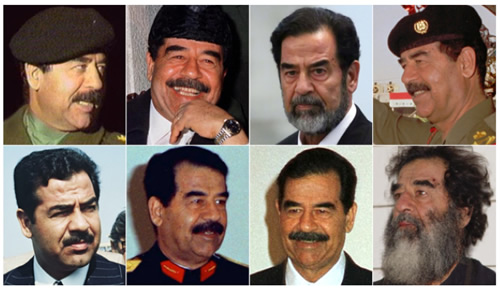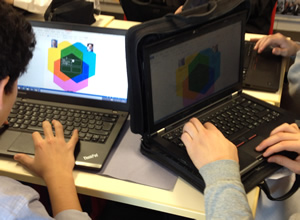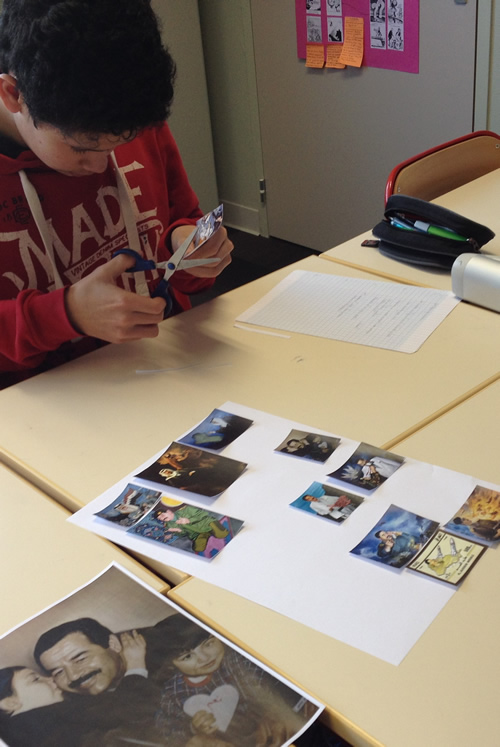Transform your history classroom
ActiveHistory provides educational, award-winning interactive simulations, decision-making games, self-marking quizzes, high-quality worksheets and detailed lesson plans for the school history classroom. All resources have been designed by full-time history teacher Russel Tarr.
An ActiveHistory subscription provides everything you need to construct and deliver a History course from start to finish for the entire 11-18 age range!
These consist not just of lesson plans, worksheets and teacher notes, but also multimedia lectures and interactive games and historical simulations ideal for remote learning and self-study.
World History teaching resources for the high school classroom: lesson plans, worksheets, quizzes and simulation games for KS3, IGCSE, IB and A-Level teachers.
 Why did Events in the Gulf Matter, c.1970-2000?
Why did Events in the Gulf Matter, c.1970-2000?
1. Why was Saddam Hussein able to come to power in Iraq?
Why was Saddam Hussein able to come to power in Iraq?
This detailed worksheet provides students with a comprehensive narrative of Saddam's rise to power, broken into two 'chapters' which each have specific questions and tasks attached to them. There are also links to appropriate segments of online video resources and a series of follow-up tasks including a Diamond9 task and a 'takeaway homework' where students choose one of several possibilities, including:
- Describe Saddam in three words. Under each word provide a piece of evidence to explain your choice and an appropriate icon / symbol.
- Produce a 'Living Graph' to illustrate Saddam's rise to power.
- Produce a DVD inlay for a fictional documentary about Saddam's rise to power.
- Produce a movie poster for a fictional Hollywood film about Saddam's rise to power.
- Produce a resource designed to highlight the similarities and differences between the rise of Hitler and the rise of Saddam.
Fling the Teacher Quiz: The Rise of Saddam Hussein
2. Why was there a revolution in Iran in 1979?
Introductory Slideshow
In this teacher-led presentation (during which students should take notes), the class is presented with some of the key questions, images and personalities relating to the 1979 Revolution. In particular, the presentation encourages students to see Iran in its long-term context and to consider how today it appears to again be going through a period of change and development. They will also be encouraged to consider the possibility than rather being a coup d'etat against liberal democracy, the Islamic Revolution was actually a popular uprising against Western exploitation.
Why had the Shah become so unpopular by 1979? - Hexagons exercise
Students are presented with 30 key facts helping them to answer the question, in the form of hexagons. They then analyse, categorise, link and prioritise these using the format described in this post: "Using Hexagon Learning for categorisation, linkage and prioritisation" at the ClassTools Blog. I have also programmed an Online Hexagons Generator.
Practice Sourcework Paper in the style of IGCSE: "Why was there a revolution in Iran in 1979?"
A model sourcework exercise in the style of IGCSE, complete with mark scheme.
Interactive Crossword Test: The Iranian Revolution
Created using the HTML5 Crossword Generator at www.classtools.net. There is also a worksheet version.
 3. What are the most frequent methods and conditions that lead to the rise of dictators?
3. What are the most frequent methods and conditions that lead to the rise of dictators?
Compare and Contrast the Rise of Three Dictators
At this point students are given the opportunity to compare and constrast the rise of Saddam, Khomeini and one other dictators (e.g. Hitler) that they have studied. Working individually, then in jigsaw groups, they build up a Venn Diagram
HexVenn Template
The final stage of this part of the study is an individual Venn diagram and a written answer to the key question. This template helps them gather their thoughts effectively.
4. What were the causes and consequences of the Iran-Iraq War, 1980-88?
Task: A biased government speech explaining the causes of the war
On the 22nd September 1980, the longest conventional war of the 20th Century began when Iraq launched an invasion of Iran. The Iraqi President, Saddam Hussein, dubbed it the "Whirlwind War" in which he expected Iran to be defeated relatively swiftly due to the turmoil it was experiencing after the overthrow of the Shah by Ayatollah Khomeini.
Sourcework Practice: Causes of the Iran-Iraq War
1. According to Source A, why did Saddam Hussein decide to invade Iran in September 1980?
TIP: as with any 'why' question, provide several reasons, substantiated with quotes from the sources.
2. How reliable is Source B to the historian researching the reasons why the Iran-Iraq war lasted for as long as it did? Explain your answer using details from the sources and your own knowledge.
Why did the Iran-Iraq War last for so long?
Before reading the additional information in the worksheet, students should have made notes from the two short video clips [clip 1 | clip 2], focusing on the question "Why did the Iran-Iraq War last for so long?". After reading further information provided AND watching the video clips, students answer the question by providing - as always - THREE key reasons.
To what extent do you agree that there was no victor in the Iran-Iraq war of 1980-88?
At the end of the war, both the Ayatollah and Saddam claimed victory and historians have continued to debate the reality of the situation ever since. "Your teacher will put you into three teams: Iraq, Iran, International Observers. The first two teams need to produce a speech persuading the International Community that there country were the victors in the war. Whilst they are preparing this, the third team should be taking further notes from the podcast episode on the war. Then the class will be organized into groups of three (with each group containing a representative from each of the original three groups). The Iranians and Iraqis will try to persuade the International Observer of their point of view. The International Observer must produce a final judgement which both sides are happy to accept".
- Podcasts:
- Witness: The Iran Iraq War: "In the autumn of 1980 Iraq began one of the longest wars of the 20th century."
- Witness: Attack on the Osirak reactor: "It is 30 years since Israeli warplanes destroyed a nuclear reactor in Iraq."
Fling the Teacher Quiz: The Iran-Iraq War
5. Why did the First Gulf War take place?
Focus Point 1: Why did Saddam invade Kuwait?
"Listed below are various factors relating to the decision to go to war.
Use these to produce TWO brief speeches in role as Saddam:
a) To the Iraqi people (your 'public' motives)
b) To your own advisors (your 'private' motives)"
Focus Point 2: Why, and with what results, was an international coalition formed against Saddam Hussein?
Students conduct further research on Operation Desert Shield and Operation Saber, then complete a sourcework question ("How useful is this cartoon to the historian studying the reasons why an international alliance was formed against Saddam when he invaded Kuwait?").
Focus Point 3: What were the consequences of the First Gulf War?
Students use the information provided to provide an infographic about the impact of the First Gulf War, then complete two sourcework questions ("To what extent does Source A prove that the United States was to blame for Iraq's invasion of Kuwait?" and "Why, according to Source B, did President Bush decide not to invade Iraq after liberating Kuwait?").
Extension / Revision Task: Additional Notes from the video clips
Two short video clips are hyperlinked from this document (8mins and 11mins in length), providing further useful information on the three key points highlighted above.
- Podcasts:
- BBC Witness: Perez de Cuellar goes to Baghdad: "In January 1991 there was a last minute attempt to stop the first Gulf War..."
- BBC Witness: Shot down in Iraq: "It is 20 years since the height of the Gulf War which followed the Iraqi invasion of Kuwait. Listen to the story of one British airman, shot down and captured by Iraqi forces..."
- Witness: Farzad Bazoft: "The British journalist was accused of spying and executed in Iraq in 1990."
- BBC Witness: Saddam Hussein's 'Human Shields': "In 1990, the Lockwood family were held as 'human shields' in Iraq in the run up to the First Gulf War..."
Mission Mapquest: The Gulf Wars and the Future of the Region [interactive]
Follow the clues in this Google Scavenger Hunt! There are 9 questions in total. You will get a clue that will help you figure out the location of the answer. Collect the gold coins at each location and enter your name in the leaderboard. Take a screenshot of your final result (which should be 100 points and your full name).
Fling the Teacher Quiz: The Gulf War
 6. What was the nature of Saddam Hussein's rule in Iraq?
6. What was the nature of Saddam Hussein's rule in Iraq?
Overview: Terror, Achievements, Propaganda
"Using your findings from this resource, produce a written response to the following question:
'Was Saddam's rule of Iraq was based on fear, propaganda or genuine achievements?' Explain your answer by connecting all three factors."
Saddamarama: Propaganda Images from Saddam's Iraq
"You will be divided into teams. One person from each team will come to the front and collect a propaganda image. Without showing it to the rest of the team, this person should describe what they see, who it appears aimed at, and what it is trying to say about Saddam. Everyone else takes notes, then a second person collects a fresh picture when the discussion is finished. This process can take place over 10-15 minutes. Afterwards, you will be given a copy of some of the photographs. Arrange and annotate these on A3 paper under the heading 'What impression of Saddam is created by his propaganda?' using your notes to help you. This makes use of the Talkers and Listeners Approach outlined in detail at Tarr's Toolbox.
In what ways were Saddam's attacks on the Kurds and the Shia similar, and in what ways were they different?
"After working through this material, make additional notes on the Anfal campaign by watching (a) The video clip (7 minutes); (b) The podcast epsiode from BBC 'Witness' (9 minutes) which can be located on the ActiveHistory Podcast Database. Your teacher may ask you to work with a partner, with each of you using just one of these two sources and then feeding back with your findings"
Halabja: What really happened, and who was responsible? - Sourcework Exercise
The class will be divided into two teams. Each team needs to provide answers to each of the following questions, using the most appropriate source(s) from the list provided to help them.
TIP: If the discussion takes the form of a classroom debate, be prepared to challenge the reliability of your sources.
- Was the West justified in arming Saddam with chemical weapons during the Iraq-Iran War?
- Were the deaths of civilians part of general military operations rather than a deliberate act of genocide against the Kurds?
- If chemical weapons were used, is there any reliable evidence that they were most likely used by Iran rather than by Iraq?
- Is there any compelling evidence that chemical weapons were not even used at Halabja?
Podcasts
- The History Hour: Iraq's Marsh Arabs
- Witness: The Destruction of Iraq's Marshes
- Witness: The Betrayal of the Kurds
- Witness: Operation Desert Fox
- National Archives: The creation of the Iraqi state: 1914 to 1974
Fling the Teacher Quiz: The Rule of Saddam Hussein
7. Revision Materials
"Revising the Five Big Questions"
"The class will be divided into four team (1, 2, 4, 5). For each of the following key questions, work individually, to complete one of the incomplete rows of this table. The row on Saddam's rule provides you with a completed example to get you started. You will then be seated in a group with the other students who worked on the same row. Compare your ideas with the members of your group and make any adjustments you think are necessary. Finally, the teacher will 'jigsaw' the groups: each member of Group 1 will be given a letter (A, B, C, ...); the same will occur for groups 2, 4 and 5; then all the "A"s will sit together in one group, all the "B"s in another, and so on. In this way, each new team will have somebody that worked on one of the original rows. Take it in turns to share your findings so that at the end of the exercise everyone has a complete table of notes".
Sourcework Questions from across the topic
A document containing a wide range of sources and eight varied questions based on the main areas of the syllabus.
"Fling The Teacher" Revision Quiz (75 questions)
This quiz is great for revision purposes and covers all five syllabus focus points.
Generic Resources for revising the sourcework paper
A range of resources and exercises for developing and revising approaches to sourcework, designed to be used as stand-alone activities whatever the focus of Paper 2 each year.
Alternatively, there are a whole series of arcade games available on ClassTools.net:
There is also a PacMan version of the game.
If you prefer separate revision quizzes on each topic:
Fling the Teacher Quiz: The Rise of Saddam Hussein
Fling the Teacher Quiz: The Iranian Revolution
Fling the Teacher Quiz: The Iran-Iraq War
Fling the Teacher Quiz: The Rule of Saddam Hussein
Fling the Teacher Quiz: The Gulf War
Video Resources - DVD
Video Resources - Online
Saddam's Reign of Terror (50m)
I have also completed some teacher programme notes to provide a minute-by-minute breakdown of the themes covered.
Tyants and Dictators: Saddam (43m)
I have also completed some teacher programme notes to provide a minute-by-minute breakdown of the themes covered.
Recommended Weblinks
Podcasts on this topic from MrAllsopHistory
A superb range of revision podcasts designed by an expert history teacher. Highly recommended.

© 1998-2025 Russel Tarr, ActiveHistory.co.uk Limited (Reg. 6111680)
1 Torrin Drive, Shrewsbury, Shropshire, SY3 6AW, England
Privacy Policy | Contact









